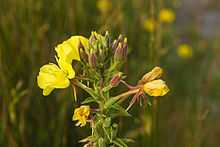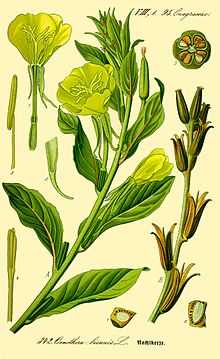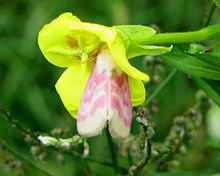Oenothera biennis
| Common evening primrose | |
|---|---|
 | |
| Scientific classification | |
| Kingdom: | Plantae |
| (unranked): | Angiosperms |
| (unranked): | Eudicots |
| (unranked): | Rosids |
| Order: | Myrtales |
| Family: | Onagraceae |
| Genus: | Oenothera |
| Species: | O. biennis |
| Binomial name | |
| Oenothera biennis L. | |
| Synonyms[1] | |
| |
Oenothera biennis (common evening-primrose,[2] evening star, or sun drop) is a species of Oenothera native to eastern and central North America, from Newfoundland west to Alberta, southeast to Florida, and southwest to Texas, and widely naturalized elsewhere in temperate and subtropical regions.[3] Evening primrose oil is produced from the plant.[4][5]
Growth and flowering



Oenothera biennis has a life span of two years (biennial) growing to 30–150 cm (12–59 in) tall. The leaves are lanceolate, 5–20 cm (2.0–7.9 in) long and 1–2.5 cm (0.39–0.98 in) broad, produced in a tight rosette the first year, and spirally on a stem the second year.
Blooming lasts from late spring to late summer. The flowers are hermaphrodite, produced on a tall spike and only last until the following noon. They open visibly fast every evening producing an interesting spectacle, hence the name "evening primrose."
The blooms are yellow, 2.5–5 cm (0.98–1.97 in) diameter, with four bilobed petals. The flower structure has an invisible to the naked eye bright nectar guide pattern. This pattern is apparent under ultraviolet light and visible to its pollinators, moths, butterflies, and bees.
The fruit is a capsule 2–4 cm (0.79–1.57 in) long and 4–6 mm (0.16–0.24 in) broad, containing numerous 1–2 mm (0.039–0.079 in) long seeds, released when the capsule splits into four sections at maturity.[6][7][8][9]
English names
It is also known as weedy evening-primrose, German rampion, hog weed, King's cure-all, and fever-plant.[10]
Ecology
The seeds of the plant are important food for birds.[11]
Uses
The mature seeds contain approximately 7–10% gamma-linolenic acid (GLA), an essential fatty acid. Evening primrose oil (EPO), containing GLA, is often used to treat some medical conditions,[12] and is considered a dietary supplement rather than a drug.
The plant's leaves are edible and traditionally were used as a leaf vegetable.[13] The roots are also edible.[11]
Medicinal uses
Evening primrose is considered to have beneficial health effects, largely due to its GLA content. Evening primrose is sometimes used to treat eczema. The Mayo clinic examined evidence for the safety and effectiveness of evening primrose for several conditions; it was considered that there was good evidence (grade B, vs "strong evidence", grade A) that it produced a moderate improvement in eczema.[12] Grade C, unclear, evidence for benefit is listed for many conditions, including some reduction of blood pressure. Research has shown a lack of significant beneficial effects on heart function and health. Many conditions for which evening primrose is a traditional remedy or there is a theory suggesting efficacy are listed by the Mayo clinic, without comment.[12]
The symptoms of eczema can be exacerbated due to scratching and drying out the skin. Supplementation with EPO may help rehydrate skin that has been scratched due to eczema.
There are conflicting opinions and evidence for the medicinal effects of GLA, the active constituent of EPO, which has been promoted to treat ailments including breast pain and eczema; such marketing was described by the British Medical Journal (BMJ) as ethically dubious—the substance was likely to be remembered as "a remedy for which there is no disease".[14] The BMJ said in 2003 that it was of no use in atopic dermatitis.[15] The American Cancer Society said in 2010 that there was very little evidence for its effectiveness as an anti-cancer agent, for which it is sometimes promoted, and "neither GLA nor other GLA-rich supplements (such as evening primrose oil) have been convincingly shown to be useful in preventing or treating any other health conditions."[16]
Adverse effects
EPO is considered likely to be safe in recommended doses.[17] It may increase the risk of bleeding, a concern for patients with bleeding disorders or taking drugs that may increase bleeding. The Mayo clinic recommends caution in people with seizure disorders or mania, and by pregnant or breastfeeding women, and publishes a long list of possible side-effects.
Most studies evaluating the effectiveness of EPO used a dose of 1600 mg of standardized extract (4 capsules) by mouth twice daily for up to 12 weeks.
-
rosette
-
flowers and fruit capsules
-

Primrose moth (Schinia florida) in flower
-

Habitat, dry and sunny
References
| Wikimedia Commons has media related to Oenothera biennis. |
| Wikispecies has information related to: Oenothera biennis |
- ↑ "The Plant List: A Working List of All Plant Species". Retrieved 7 December 2014.
- ↑ "BSBI List 2007" (xls). Botanical Society of Britain and Ireland. Retrieved 2014-10-17.
- ↑ Germplasm Resources Information Network: Oenothera biennis
- ↑ http://www.umm.edu/altmed/articles/evening-primrose-000242.htm (Retrieved 6/17/13)
- ↑ http://nccam.nih.gov/health/eveningprimrose (Retrieved 6/17/13)
- ↑ Borealforest: Oenothera biennis
- ↑ Plants of British Columbia: Oenothera biennis
- ↑ Jepson Flora: Oenothera biennis
- ↑ Ultraviolet Flowers: Oenothera biennis
- ↑ Blanchan, N. (1922). Wild Flowers Worth Knowing. Project Gutenberg Literary Archive Foundation.
- ↑ 11.0 11.1 "Lady Bird Johnson Wildflower Center". Retrieved 7 December 2014.
- ↑ 12.0 12.1 12.2 Mayo Clinic - Drugs and Supplements: Evening primrose (Oenothera spp.) - Evidence
- ↑ Gaertner, Erika E. (1968). "Additions to the list of wild edible plants preservable by the deep freeze method". Economic Botany 22 (4): 369. doi:10.1007/BF02908133
- ↑ Richmond, C. (2003). "David Horrobin". BMJ 326 (7394): 885. doi:10.1136/bmj.326.7394.885.
- ↑ Smith, R. (2003). "The drugs don't work". BMJ 327 (7428): 0–h. doi:10.1136/bmj.327.7428.0-h.
- ↑ "Gamma Linolenic Acid". American Cancer Society. 13 May 2010. Retrieved August 2013.
- ↑ Mayo Clinic - Drugs and Supplements: Evening primrose (Oenothera spp.) - Safety
External links
- Profile: Yellow Evening-primrose (Oenothera biennis) Photos, Drawings, Text. (Wild Plants of Winnipeg from Nature Manitoba)

